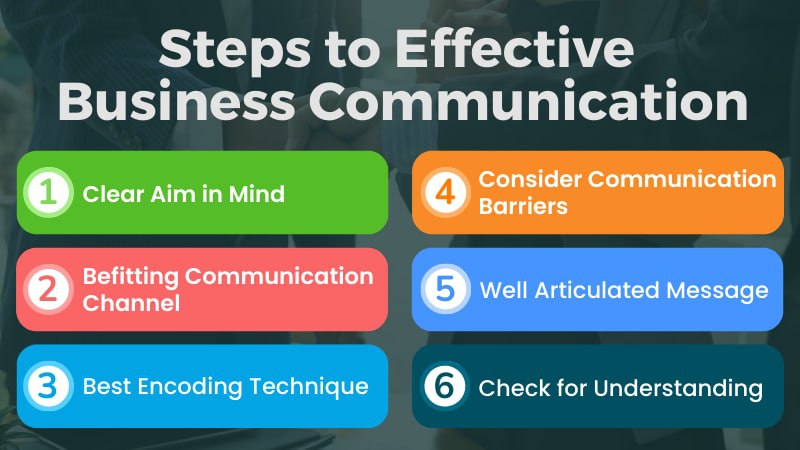7 Steps to Effective Business Communication

Business communications are always goal-oriented, precise and polite but that can make things rigorous at times. Making sure you are communicating effectively may often depend on whether the recipient is comprehending the message as expected.
Avoiding practices and language use that can miscommunicate and double-checking their effectiveness is the way to communicate effectively without fail.
Steps to Make Effective Business Communication
Business communication is no simple matter since one wrong word used can result in broken deals and lost profits. That is exactly why professional communication always needs to be effective and there are seven steps to make that happen -
1. Clear Aim in Mind
The first step of communication is to decide what to communicate and the aim of that communication. The wordings and actions change depending on what you are saying and why you are saying it. It varies between persuasion, information, requesting etc.
|
Message |
I hope you have room in your schedule for a short meeting tomorrow. |
|
Aim |
To set a meeting on the following day. |
2. Befitting Communication Channel
There are plenty of ways to convey any message in formal business settings, but it is always important to find a channel that works for the workplace and the people there. The type of message and its objective often dictates the best-suited medium or channel among - Oral, Written and Electronic channels.
- Oral Communication - Telephone, intercom, meeting, conference, presentation, face-to-face discussion etc.
- Written Communication - Memo, minutes, report, email, fax, notice, text message, forms, staff newsletter etc.
- Electronic Communication - Business emails, video messages, podcasts, online chats, text messages etc.
3. Best Encoding Technique
The encoding technique of the message would also depend on who it is subjected to, why the message is being sent out and the urgency of the news being delivered. Some things are to be written in a formal, casual and informal manner depending on office culture, the relationship between the people in contact etc. What kind of vocabulary and phrases are to be used depends largely on the message type and all these things listed below -
- Who is sending the message?
- Who is/are the recipient?
- The relationship between the sender and the recipient.
- The usual communication culture
4. Consider Communication Barriers
The communication barrier is always an issue because it affects how messages are constructed and received. It depends on the sender and receivers’ emotional barriers, cultural differences, defense mechanisms etc. and how well the other people can deal with them. Some of the major barriers in professional communication are listed below -
- Dissatisfaction or disinterest
- Lack of patience
- Professional conflict
- Cultural difference
- Language barrier
- Pent up discomfort
- Personal trauma
- Lack of trust
5. Well Articulated Message
Sending clear and to-the-point messages is the most important part of business communication. The four steps before it helps compose the message and the two after ensuring their effectiveness. Elements in the crafted message to be monitored -
- Vocabulary
- Voice
- Pitch
- Fonts
- Colors
- Formal addressing
6. Check for Understanding
After the message is sent, you have to check with the recipient if they have understood it as intended. Because of various personal and cultural communication barriers, different people may perceive the same thing differently. Questions to ensure a clear understanding -
- Have you understood the message?
- Can you explain your understanding of it?
- Was there any confusion?
- Do you have any doubt that needs to be cleared?
7. Get Feedback
Feedback is the reassuring part where everything gets sorted whether the intended messages. Messages fail if they are not received as intended. Business communication is a crucial matter and ineffective communication may result in irreparable damage.
The previous step can bring up areas requiring improvements. Getting feedback from people can entail how the communications can be improved to become more effective and to the point.
Grammar
Read More
- How to Use "Therefore" in Sentences Avoiding Common Mistakes
- How to Use "Whereas" with Examples and Avoid Common Mistakes
- When and How to Use "Thus" Correctly Without Common Mistakes
- How to Use "On the Contrary" Properly with Meaning and Examples
- When and How to Use "Either/Or" with Examples and Common Mistakes to Avoid
- How to Use "On the Other Hand" Effectively without Mistakes
- How to Use "Respectively" with Example and Common Errors to Avoid
- How and When to Use "Moreover" Without Mistakes
- How to Use "Likewise" in Sentences Based on Context & When not to Use
- When & How to Use "Although" in Sentences to Avoid Mistake




